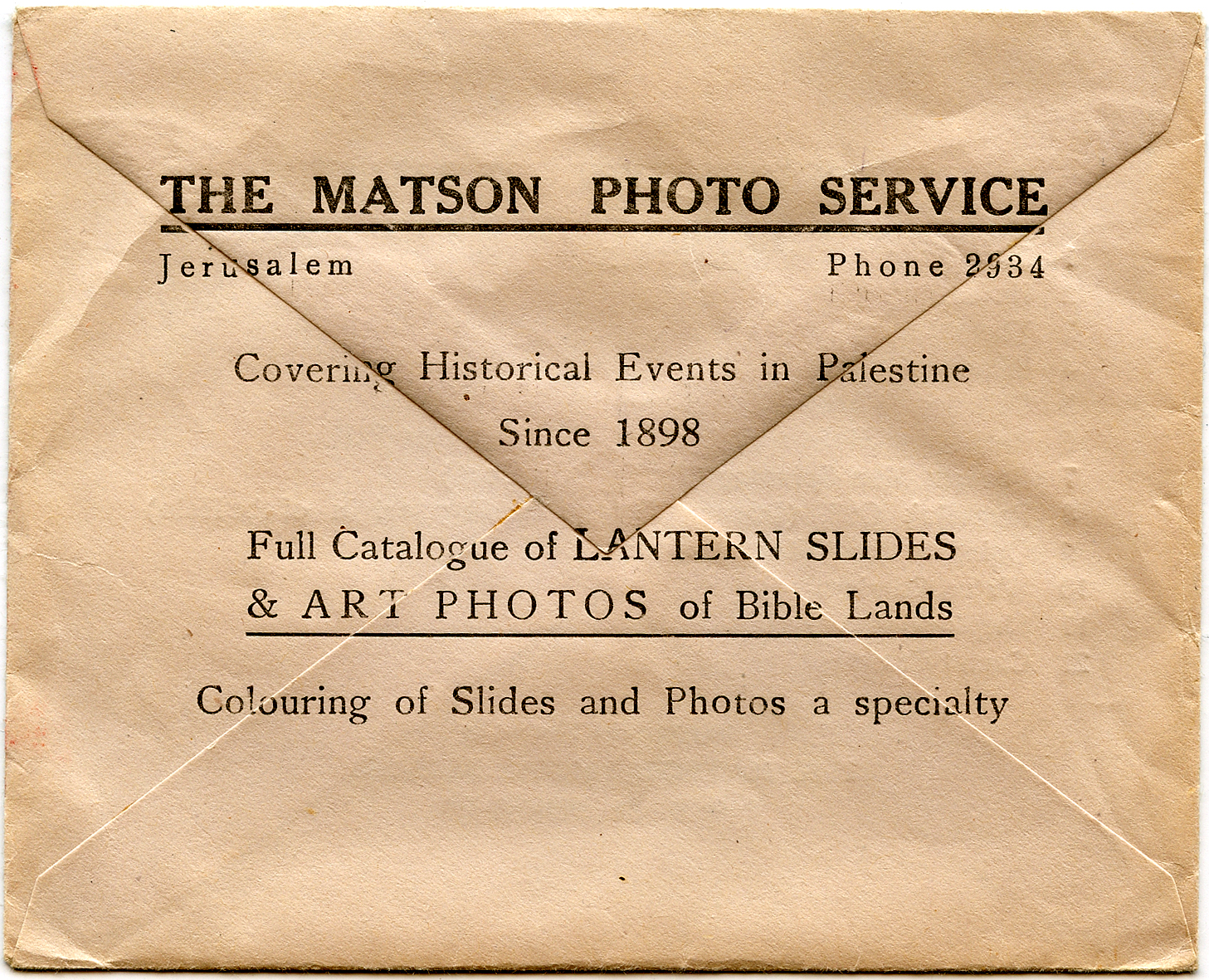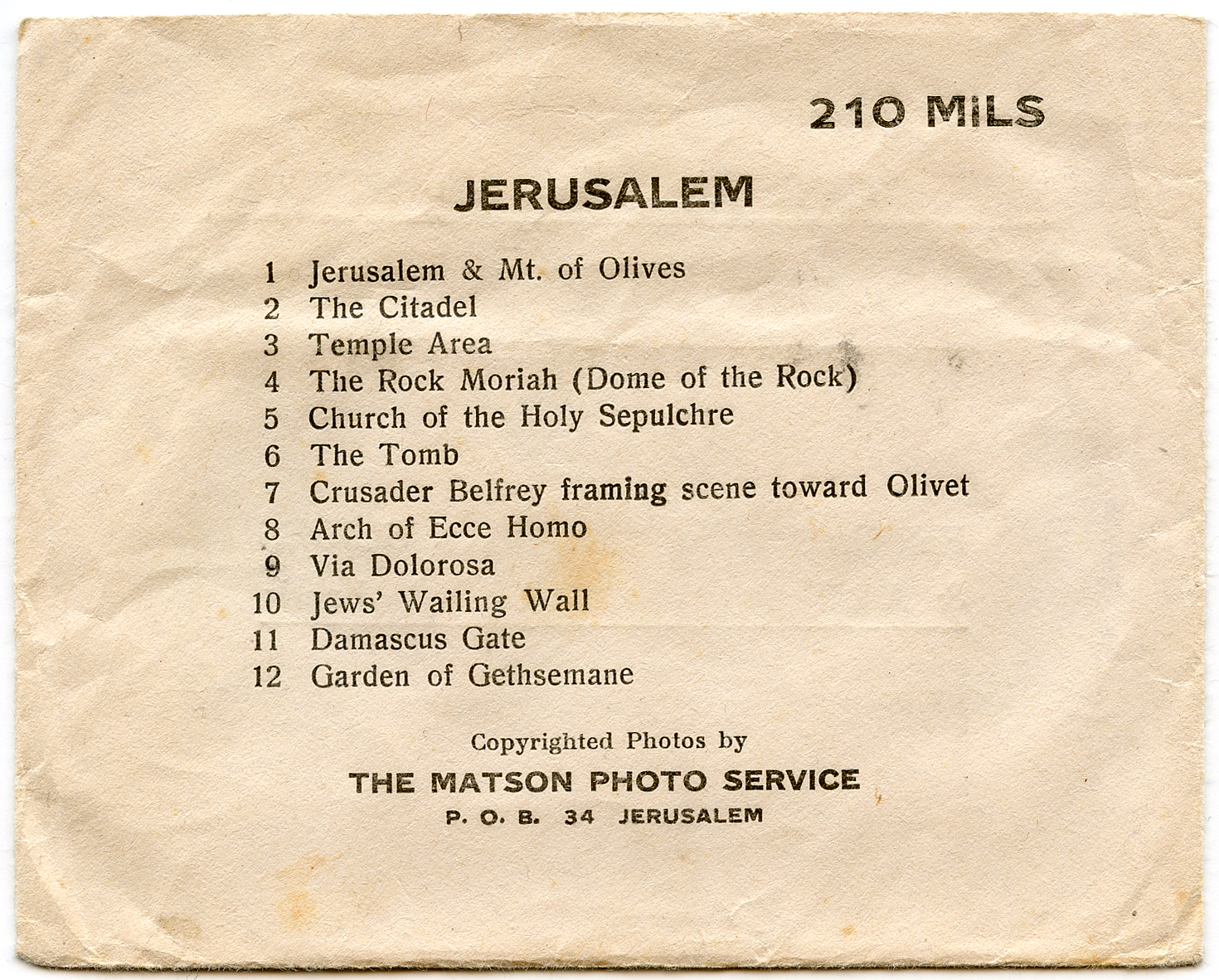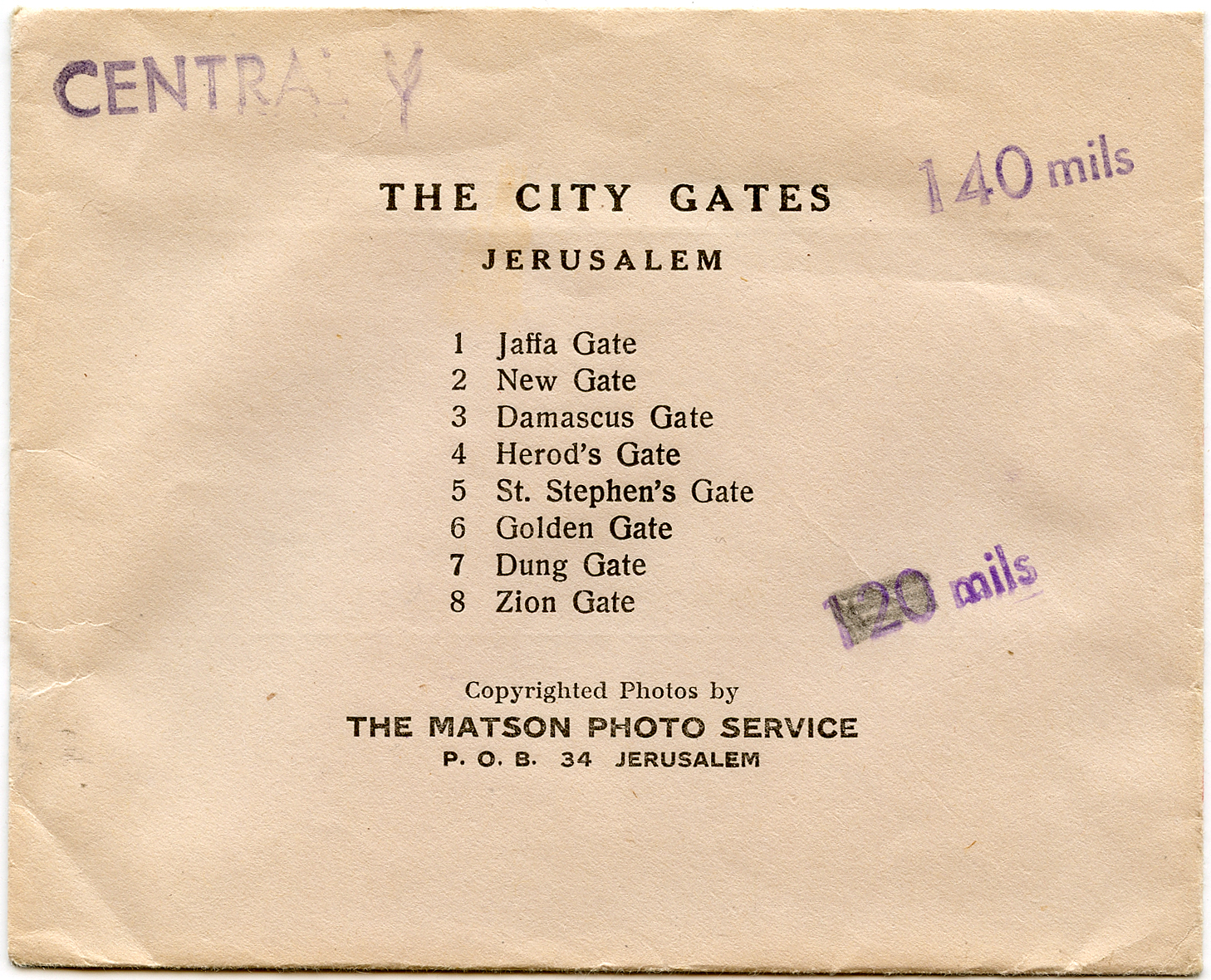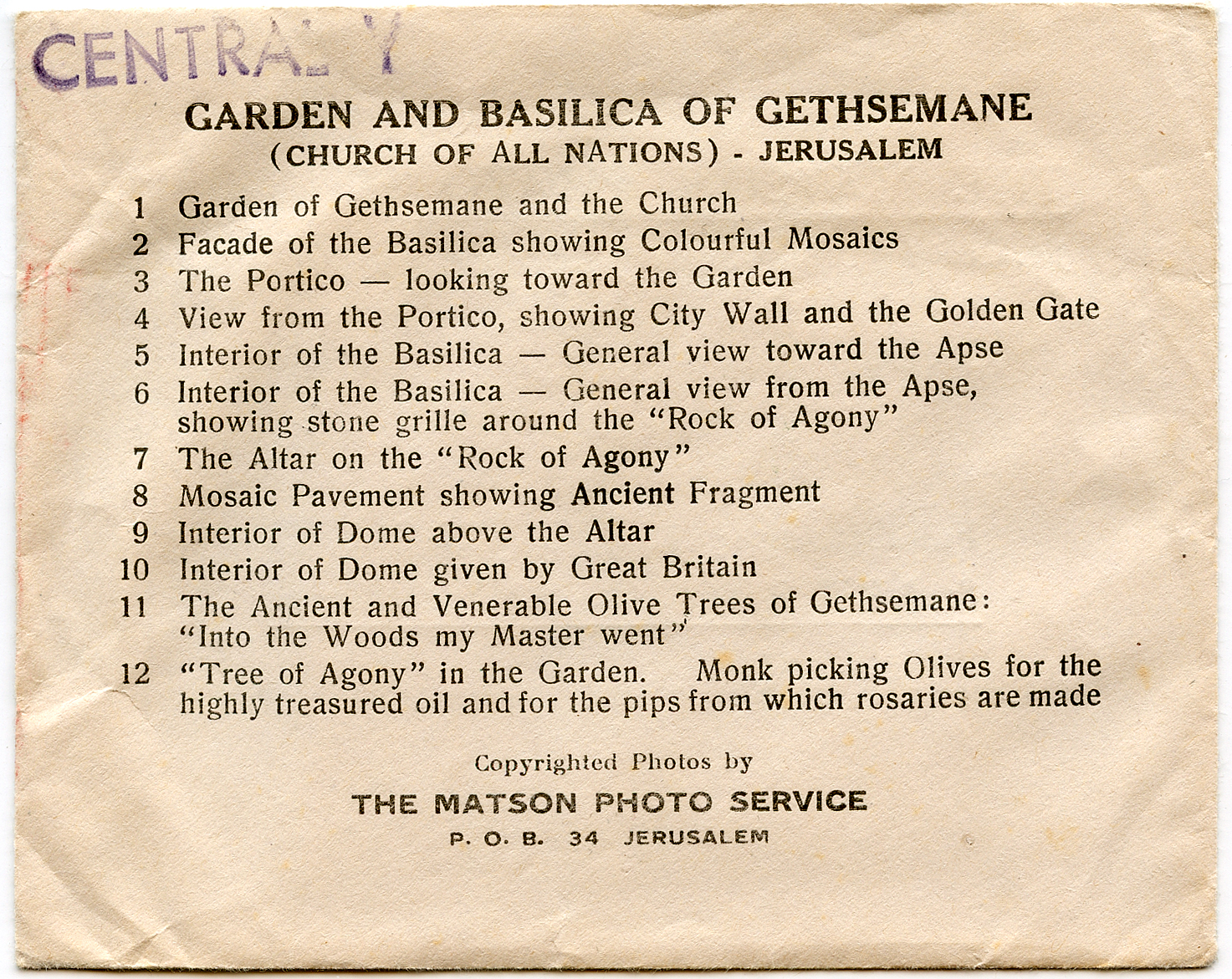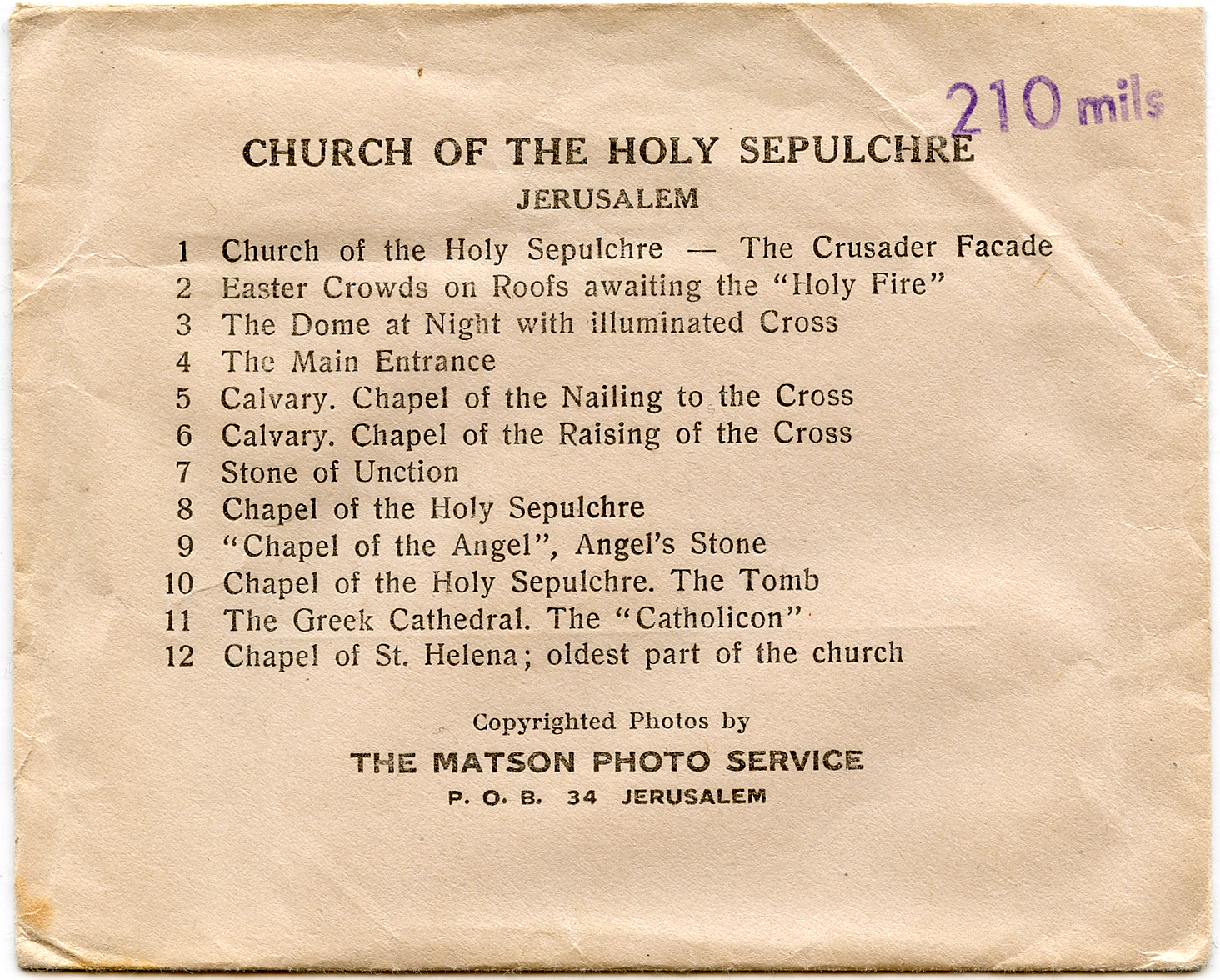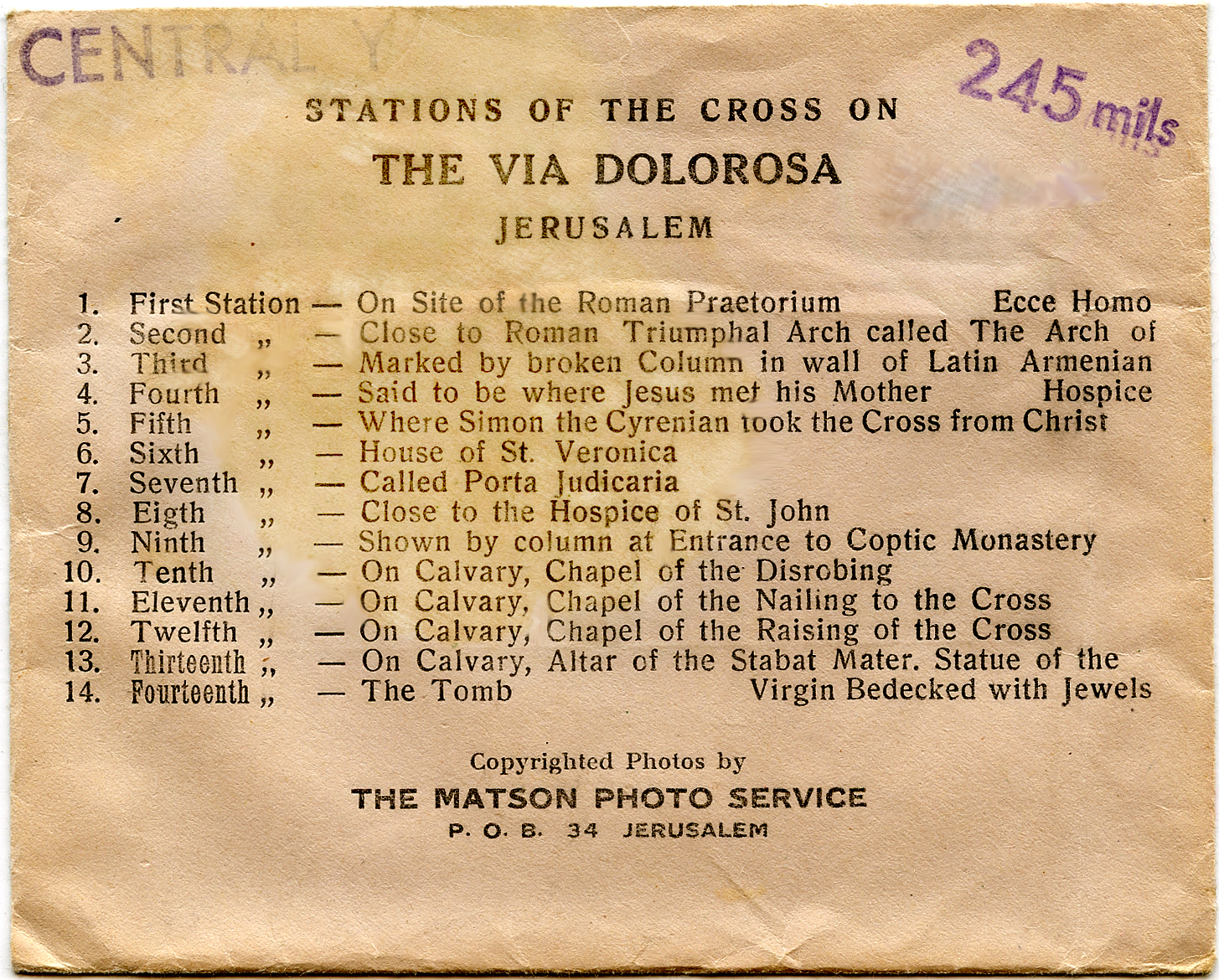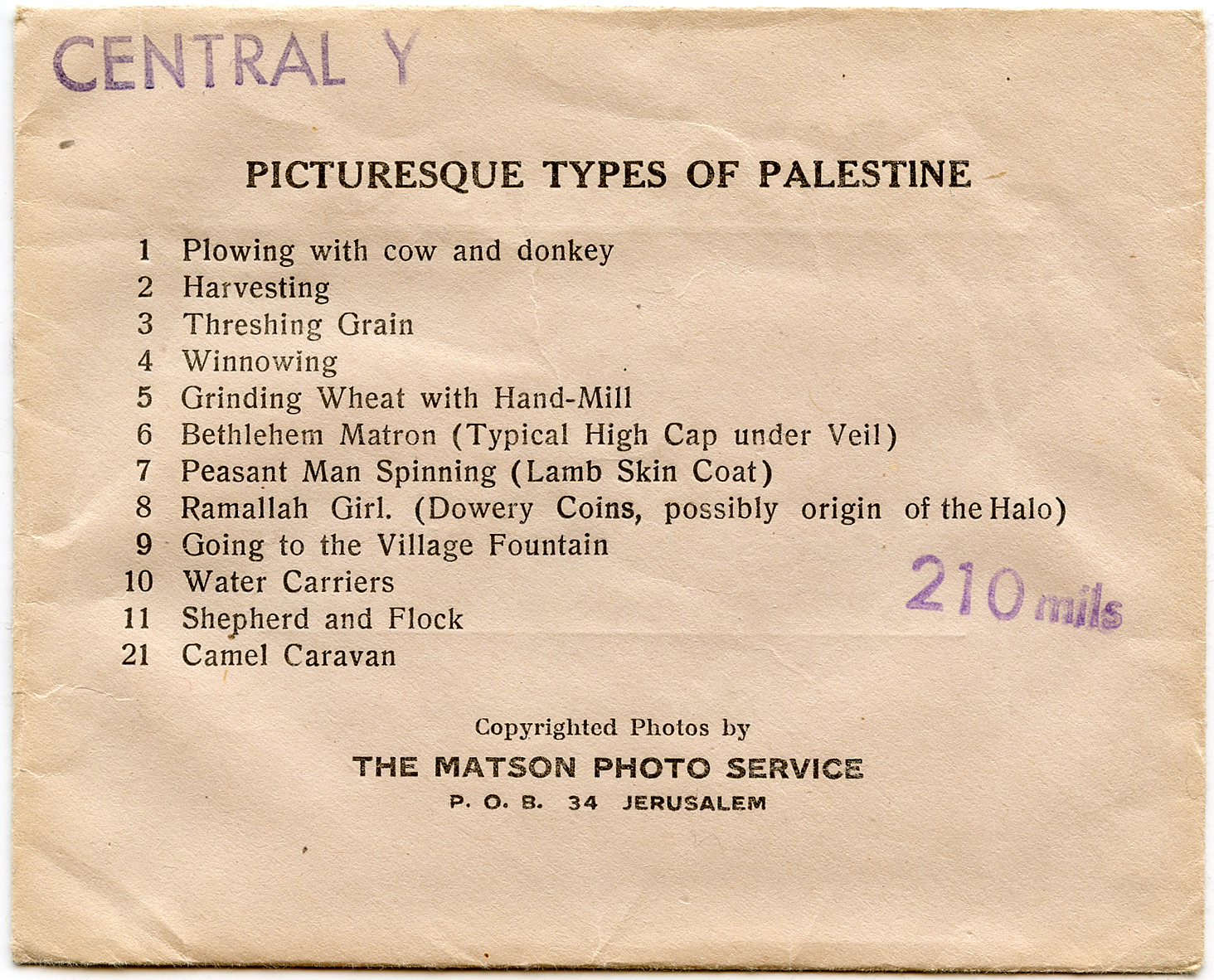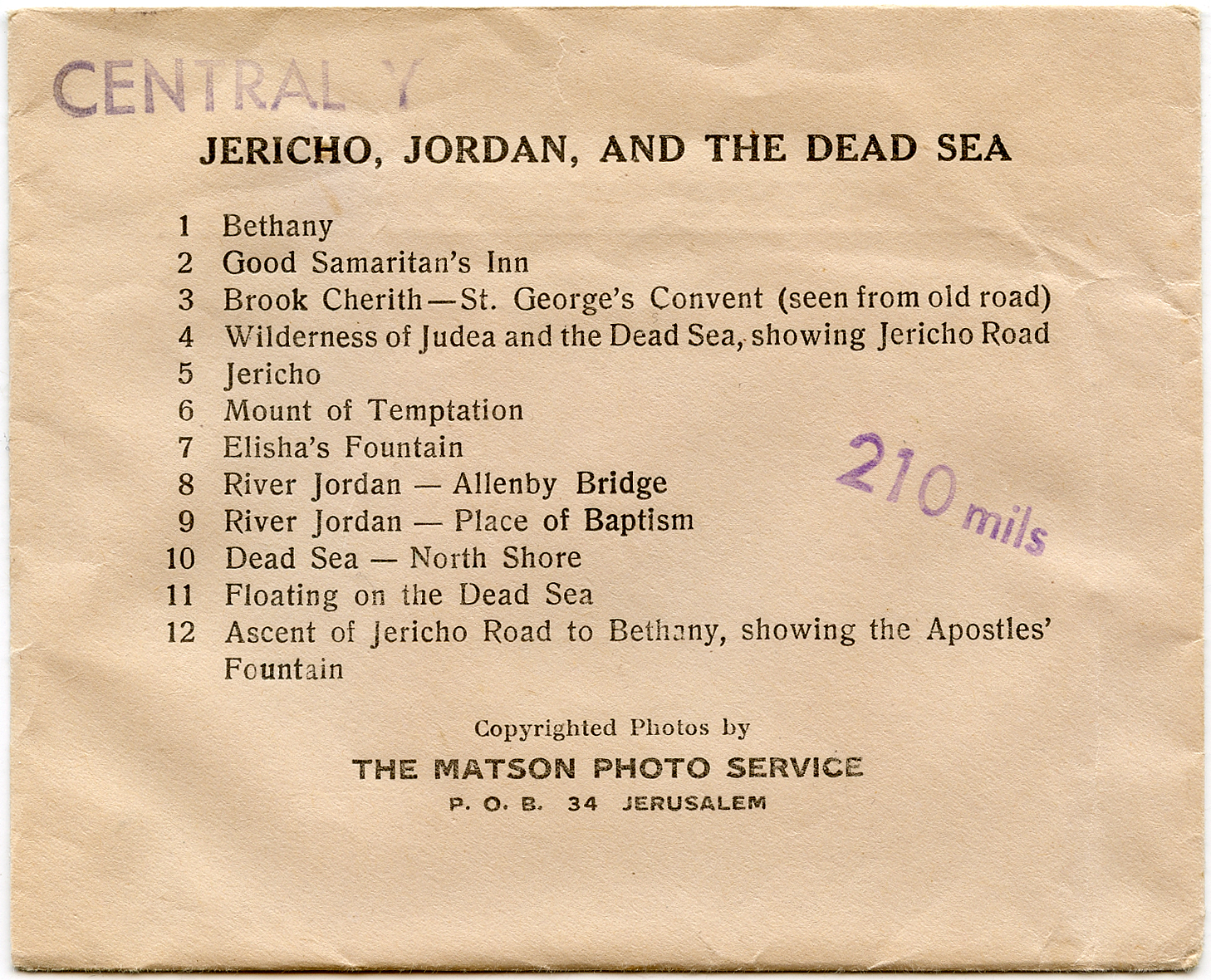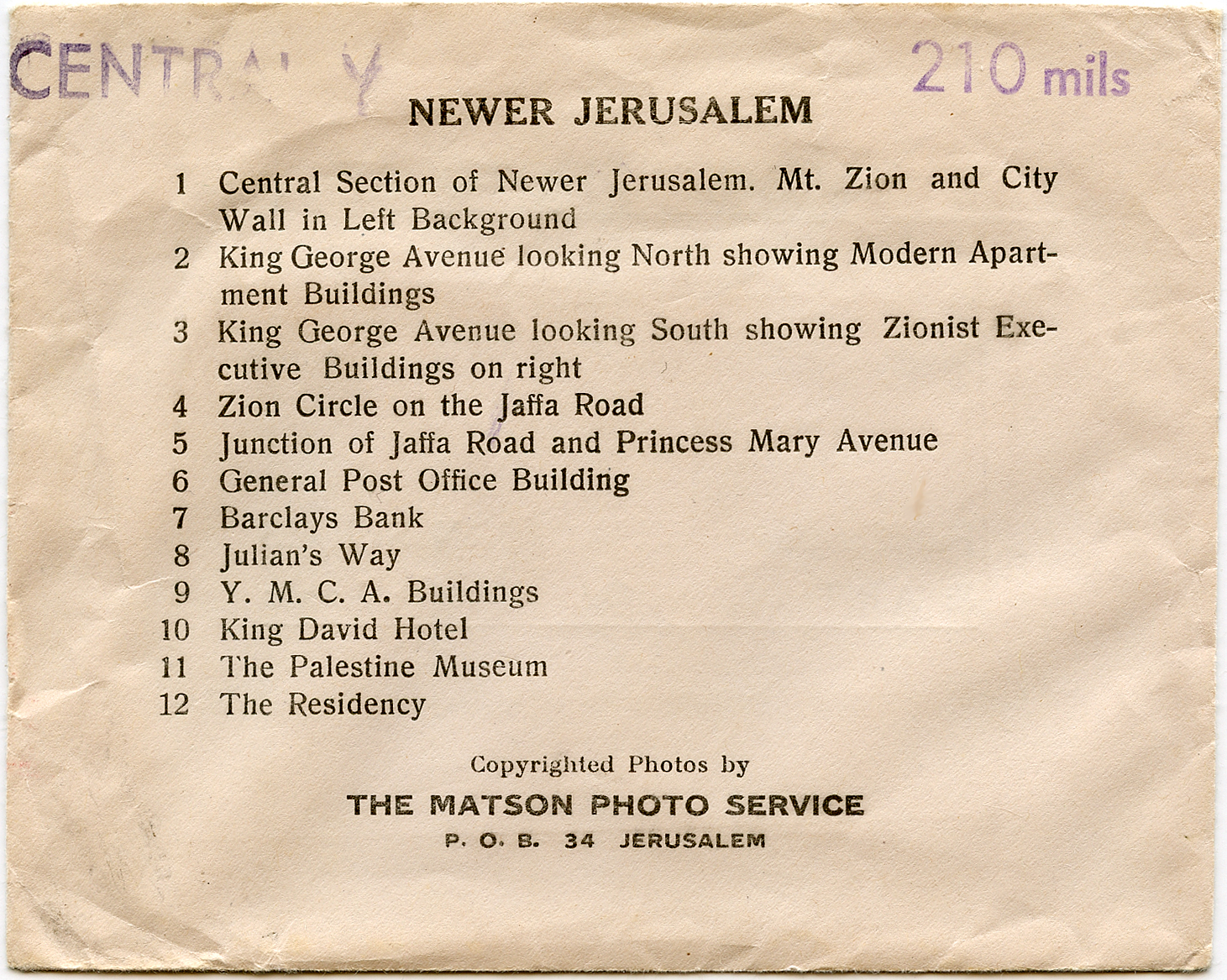View Photo Index
Introduction
Since the invention of photography in 1839, European photographers converged in Palestine to capture its historic and biblical sites. Palestine became one of the world’s most photographed places in the nineteenth century. In time, the practice of photography expanded to local photographers such as Garabed Krikorian, Khalil Raad, and the American Colony Photo Department. These photographic studios cornered the market and catered to the influx of tourists in Palestine. The contributions by the American Colony Photography Department and its successor, the Matson Photo Service, are impressively noteworthy. Their photographs captured not only aspects of Palestinian culture and its landscapes but for five decades they documented major historical and political events such as the collapse of Ottoman rule after WW I, the British Mandate period, World War II, and the conflicts between the Arabs and the Jews prior to the formation of the State of Israel.
The American Colony
The American Colony’s photography department emerged from a Christian utopian community of Americans and Swedes who emigrated to Jerusalem in search of the Second Coming of Christ. In spite of their unconventional beliefs and idiosyncratic practices which were motivated by their quest for redemption, the American Colony was known for their charitable work to the Palestinian community. Their philanthropic work in Jerusalem comprised of running soup kitchens, hospitals, orphanages and other charitable ventures. With the rise of tourism and with growing demand for images for publication, the American Colony’s photographic venture became its most successful source of income.
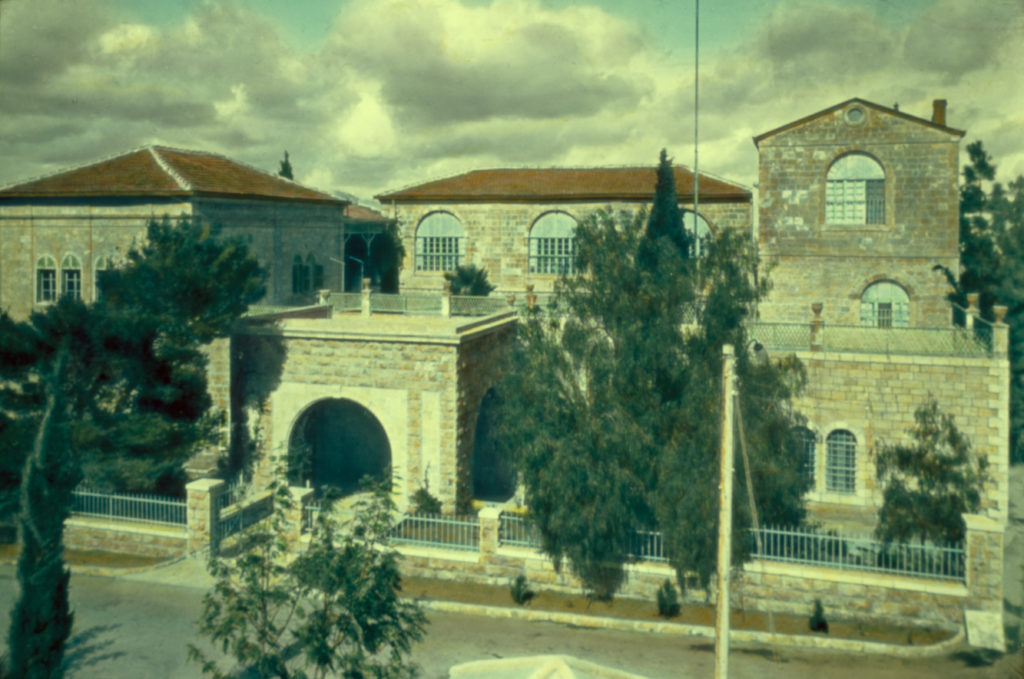 Main building of the American Colony (Matson Collection, LOC)
Main building of the American Colony (Matson Collection, LOC) 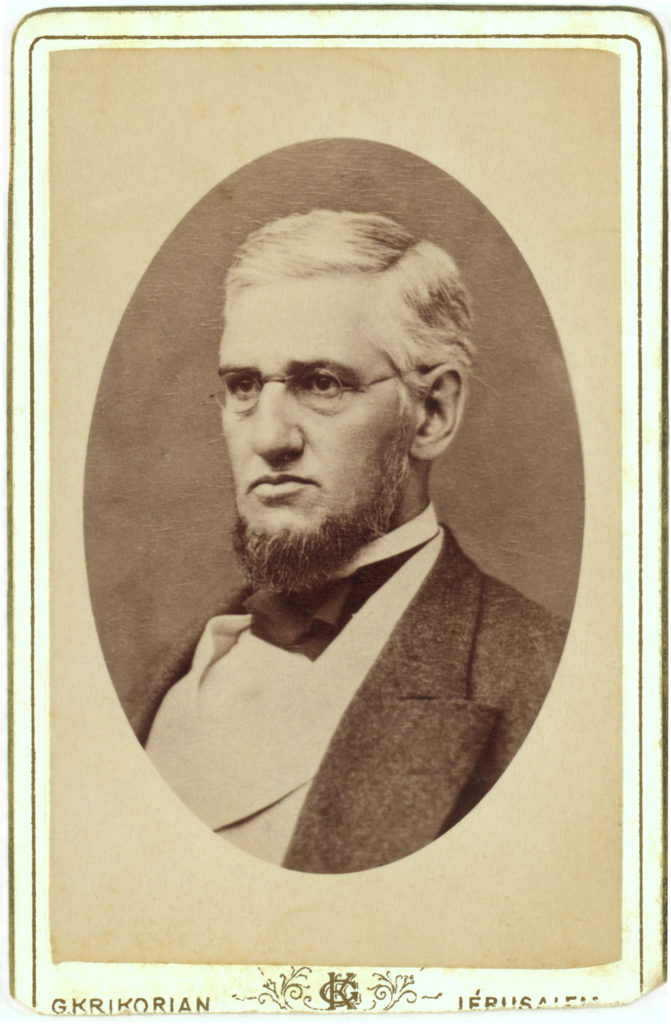 Horatio Spafford by Krikorian Studio, 1880 (Library of Congress)
Horatio Spafford by Krikorian Studio, 1880 (Library of Congress)
The American Colony in Jerusalem was established in 1881 by Anna and Horatio Spafford following multiple tragic events and personal losses. Horatio Spafford (1828-1888), a prominent lawyer and a senior partner in a large and thriving law firm in Chicago, Illinois, was regarded as a civic leader “engaged in philanthropic and Christian work, an activist in the abolitionist, temperance and other reform movements of the time.” He was a prominent supporter and close friends with the evangelist Dwight L. Moody.
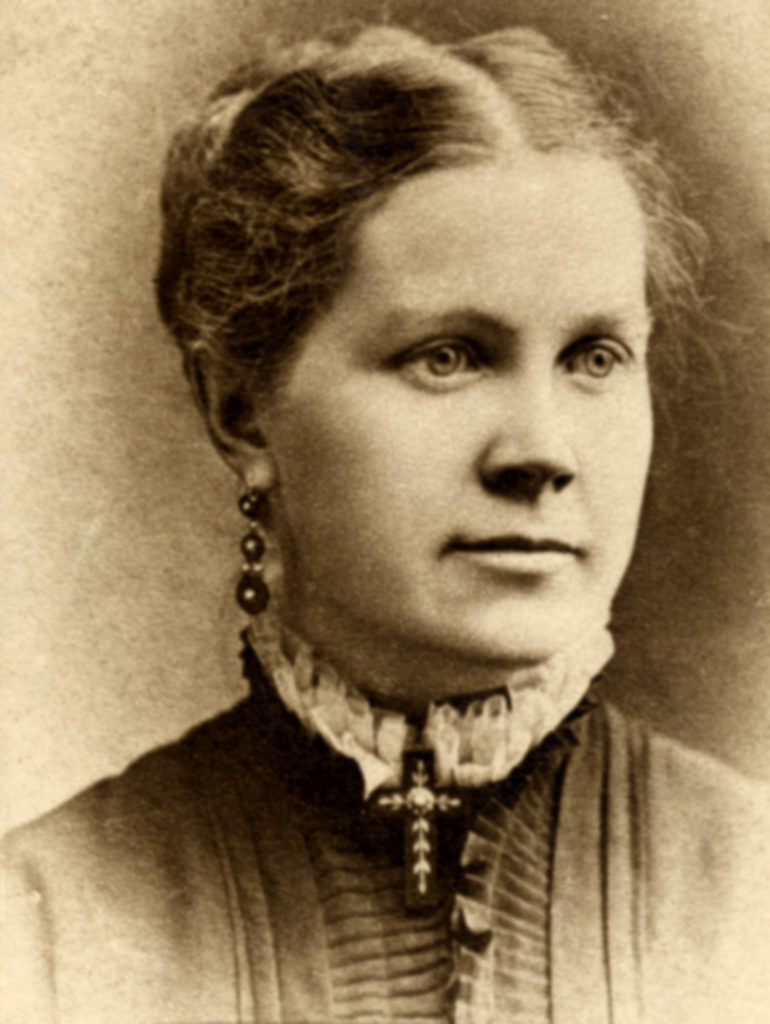 Anna Spafford, 1880 (Library of Congress)
Anna Spafford, 1880 (Library of Congress)
Anna Spafford (1842–1923), born in Norway emigrated to America as a young child with her parents. Losing her parents during her teenage years, she was sent to Chicago to live with a half-sister. In 1861, she married Horatio Spafford and together they had four daughters. What seemed to be an idyllic life for the Spaffords in the suburbs of Chicago tragically ended with the Great Fire of Chicago in 1871. Horatio Spafford’s law practice sustained severe damage from the fire which led to significant financial debt. In 1873 en route to a European family holiday on the French liner SS Ville du Havre, the ship collided with a British vessel leaving Anna unconscious amongst floating debris. While Anna survived, it tragically ended the lives of her four young daughters at sea. The death of yet another child in 1880 was one more traumatic event that led the Spafford’s onto a journey of radical spiritual transformation that departed from accepted Protestant creeds. The Spaffords were perceived as “so crazed by grief that they lost touch with reality,” and they “found compelling reasons to see heaven and hell through a rather special light of their own.”
With this backdrop of tragedy and personal transformation, the Spaffords organized a group of friends called by the American press as the “Overcomers.” They set sail for Jerusalem in 1881 to find comfort and consolation in the Holy Land. It was Anna’s “message” from God that they go to Jerusalem to await the Second Coming of Christ and to “find refreshment of the body, soul and spirit.”
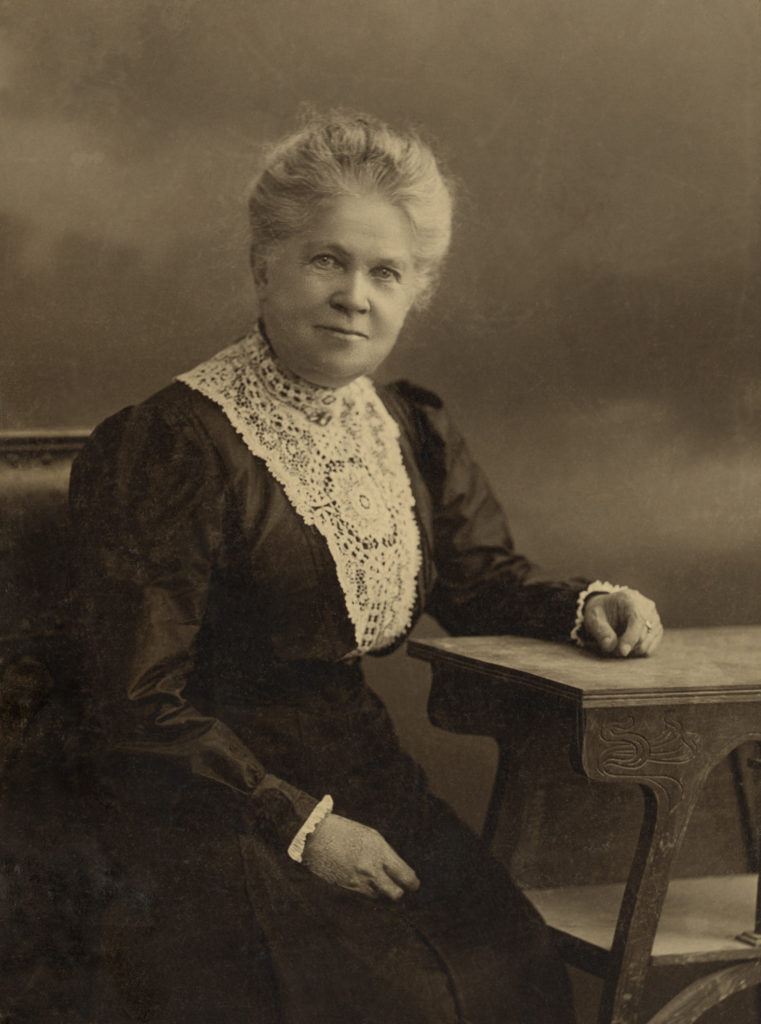 Anna Spafford, ca. 1915 (Library of Congress)
Anna Spafford, ca. 1915 (Library of Congress)
In Jerusalem, the “Overcomers” or “The American Colony” as they were called established a communal lifestyle devoted to a “daily routine of work, prayer, worship and study.” They committed themselves solely to philanthropic work, and unlike the Protestant missionaries in Jerusalem they were not driven by a religious calling to proselytize. Following the death of Horatio Spafford of malaria in 1888, Anna took control of the American Colony. Under her leadership which was influenced by “messages” from God, the American Colony “took on a narrower, more somber and tightly-controlled character.” Anna was regarded as a “superb despot” who did her best “to crush individual spirit and enhance submission through fear and awe.” The influx of American and Swedish pilgrims settling within the confines of the compound led to new lucrative enterprises that bolstered the financial status of the American Colony. After the turn of the century, the Colony embraced the tourist trade and established a thriving store for souvenirs and a hostel for travelers.
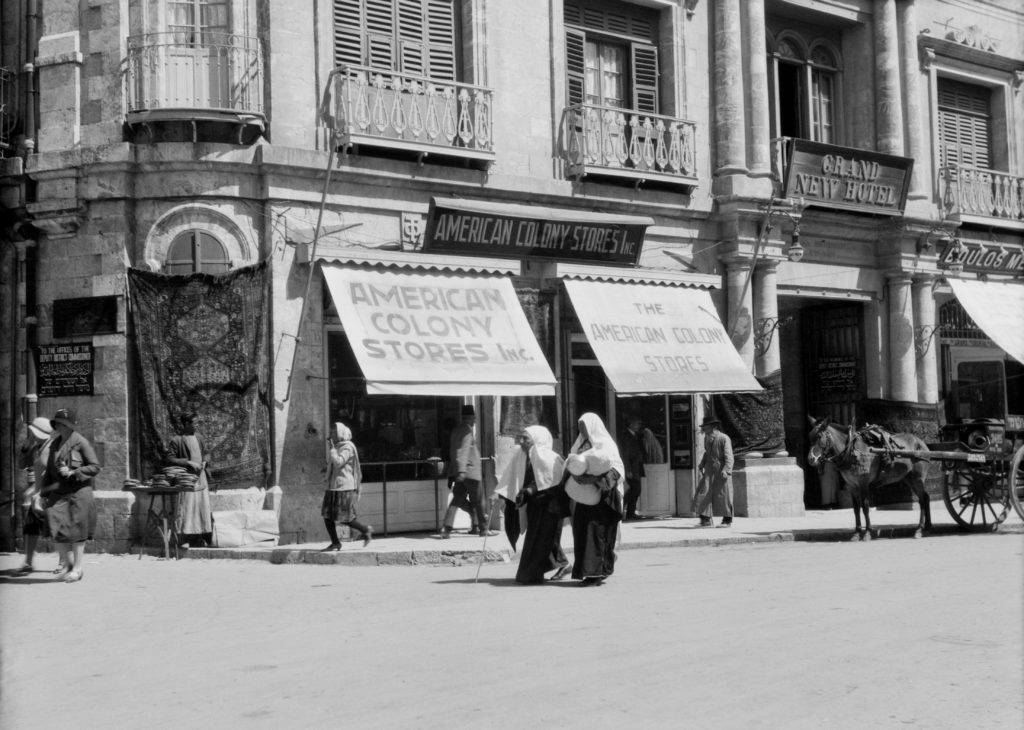 The American Colony Stores inside Jaffa Gate, ca. 1920 (Matson Collection, LOC)
The American Colony Stores inside Jaffa Gate, ca. 1920 (Matson Collection, LOC) 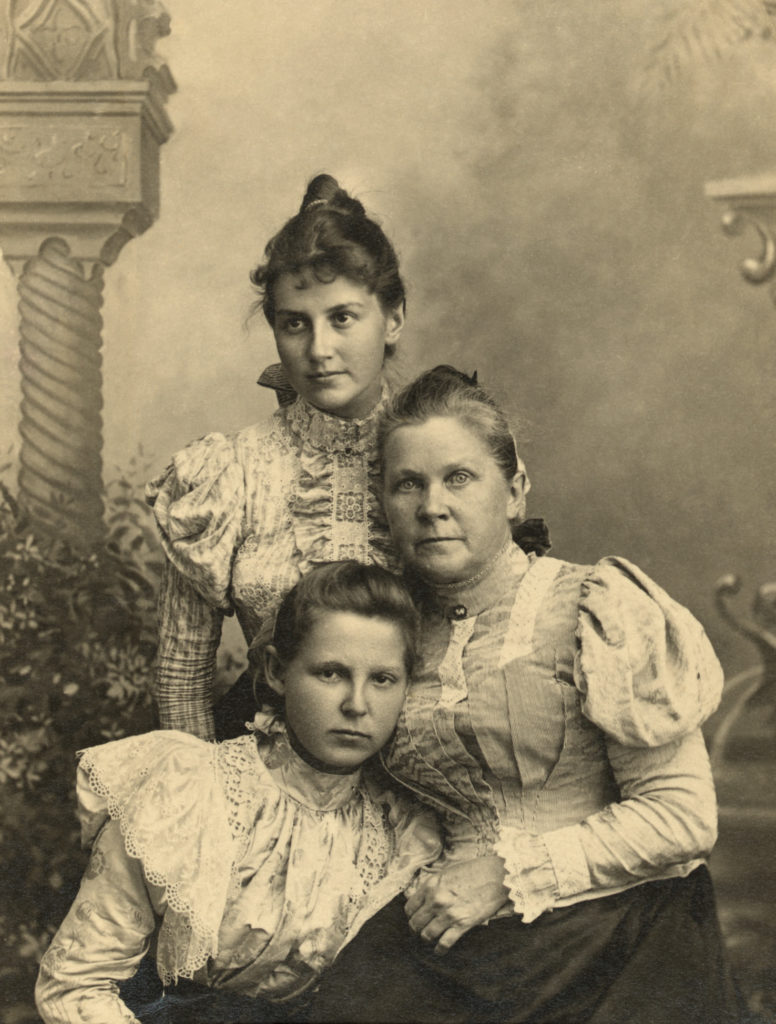 Anna Spafford, Bertha Spafford Vester, and Grace Spafford Whiting, ca. 1895 (Library of Congress)
Anna Spafford, Bertha Spafford Vester, and Grace Spafford Whiting, ca. 1895 (Library of Congress)
Under Anna’s autocratic and divisive leadership, the American Colony became more fractured with the Swedes becoming disenchanted by her vigorous attempts to suppress Swedish “culture, nationalism and language.” Eventually, the marginalized Swedish contingency broke away from the American Colony. With the death of Anna in 1923, the Spafford daughters, Bertha Spafford Vester (1879-1968) and Grace Spafford Whiting (1881-d.) worked towards denouncing and dismantling many of Anna’s rigid doctrines and practices. They reorganized and instituted “a new openness to the outside” thereby “giving them a new respectability at the center of Jerusalem society.” The American Colony was now regarded as a business and charitable venture rather than a religious sect or cult.
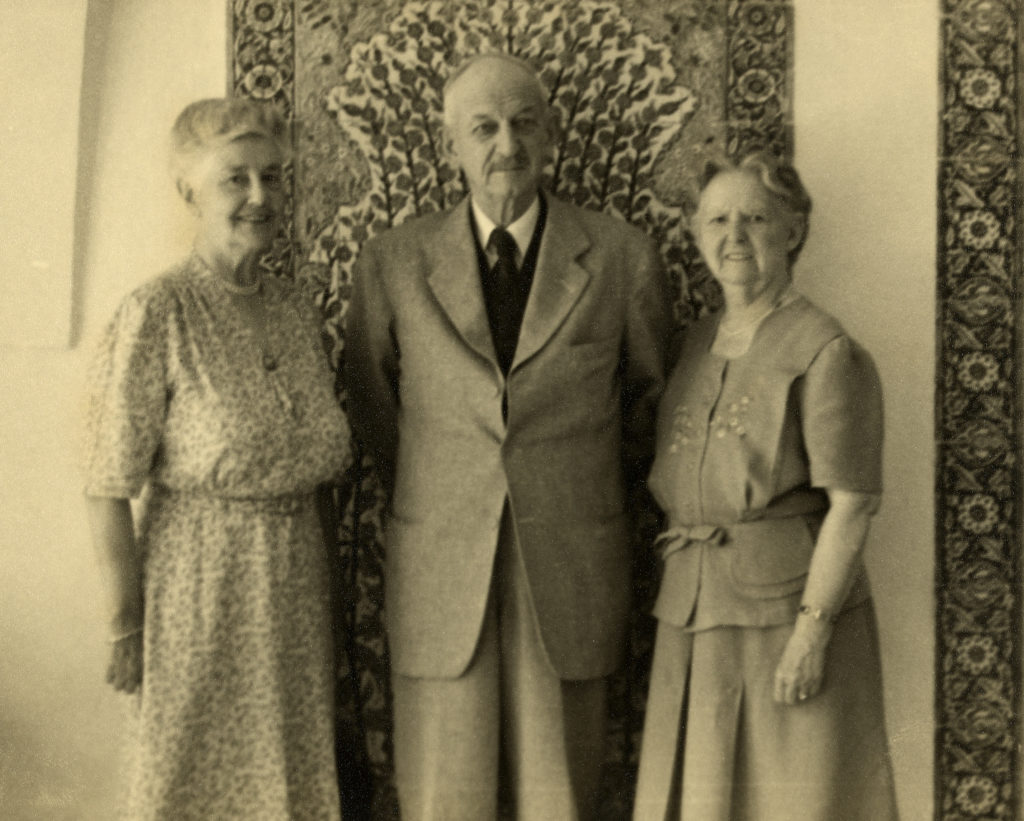 John Whiting, with Bertha Vester (left) and his wife, Grace Whiting (right), ca. 1950 (Library of Congress)
John Whiting, with Bertha Vester (left) and his wife, Grace Whiting (right), ca. 1950 (Library of Congress)
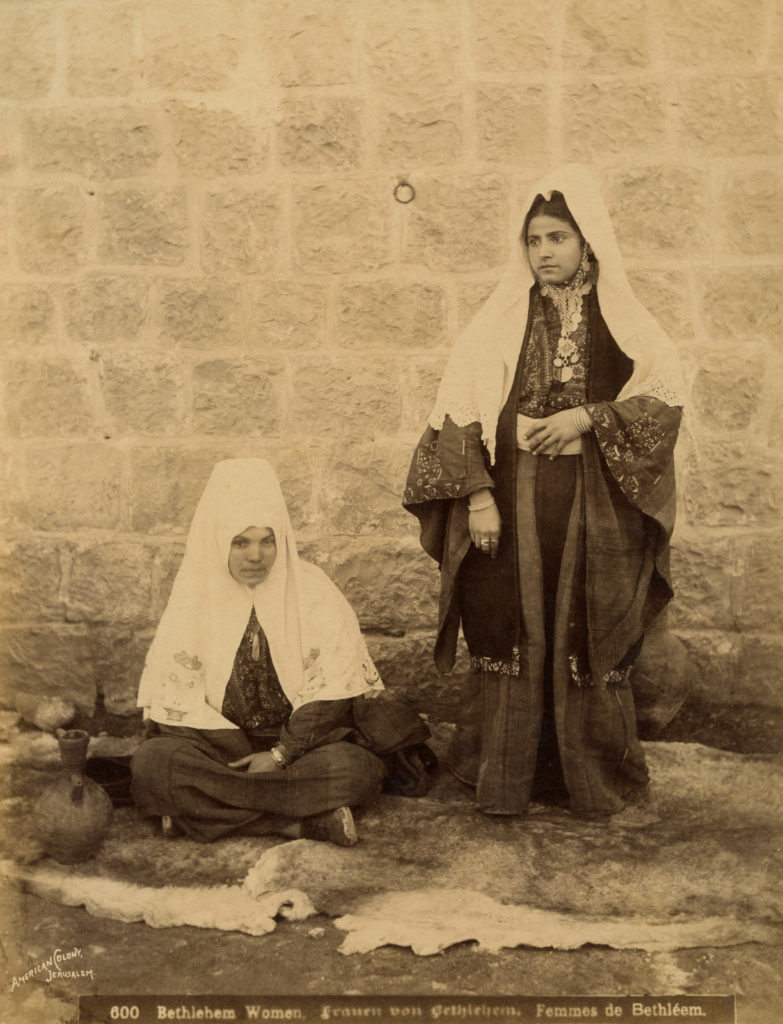 Women from Bethlehem, ca. 1900 American Colony (Malikian Collection)
Women from Bethlehem, ca. 1900 American Colony (Malikian Collection)
The American Colony
Photography Department
The most lucrative enterprise established by the American Colony was their operation of a photo service. The eccentric Elijah Meyers who became a dedicated follower of Anna Spafford emigrated to Jerusalem from India in the early 1890s as a Jewish convert to Christianity. His knowledge of photography from his early days in India led him to capture images of people, places and events in and around the city of Jerusalem. His devotion to photography resulted in the formation of a photographic division within the American Colony. Under his direction, Meyers trained the next generation of photographers such as Fareed Naseef, the brothers Erik, Olaf, Lars and Nils Lind, and Furman and Norman Baldwin.They are credited with the large volume of images produced in the first decades of the twentieth century. Unfortunately, due to the Colony’s collaborative and collective culture, it has been difficult to identify and to ascribe credit to the individual photographers. The photographic coverage of the historic visit of the German Kaiser, Wilhelm II, to Jerusalem in 1898 to dedicate the German-Protestant Redeemer Church was a turning point for the photo department. This event and the ensuing “golden era” of the photo department afforded them international exposure, recognition and significant monetary gain. It also facilitated a “way out from their closed universe” imposed by Anna Spafford. Under the direction of Elijah Meyers, the many photographic expeditions taken from 1903 to 1913 throughout Palestine and its surrounding countries produced images that were sold to various international publications like National Geographic Magazine.
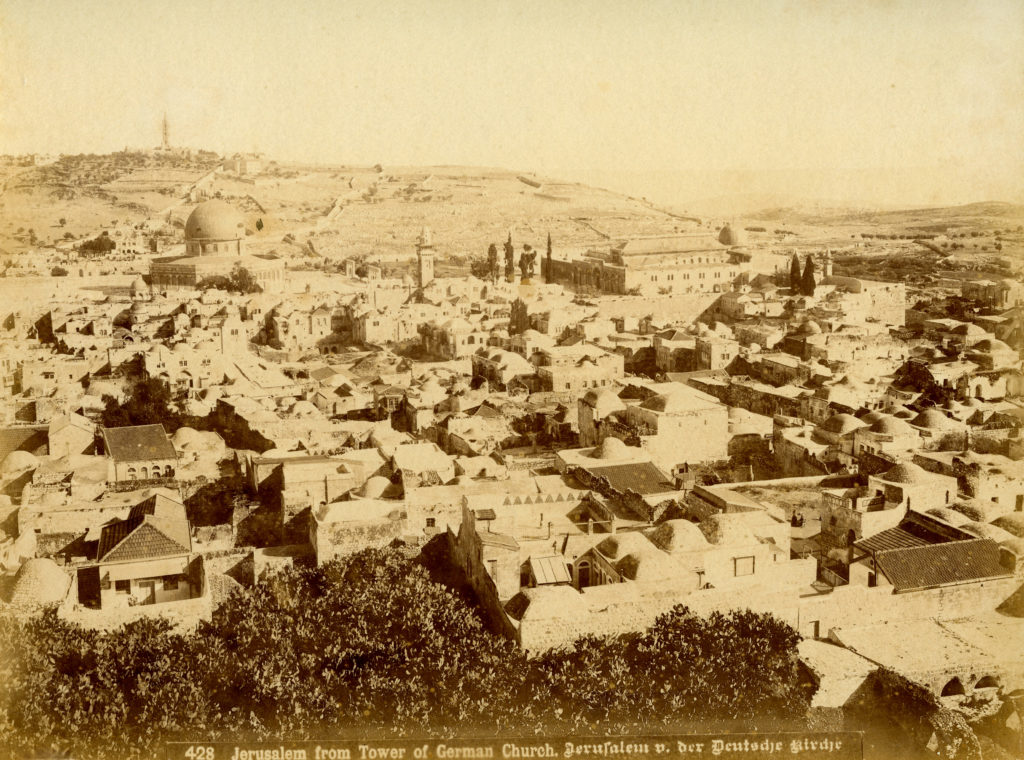 General view of the Mosque of Omar (Dome of the Rock) and Al-Aqsa Mosque from the tower of the German Church, ca. 1900 American Colony (Malikian Collection)
General view of the Mosque of Omar (Dome of the Rock) and Al-Aqsa Mosque from the tower of the German Church, ca. 1900 American Colony (Malikian Collection) 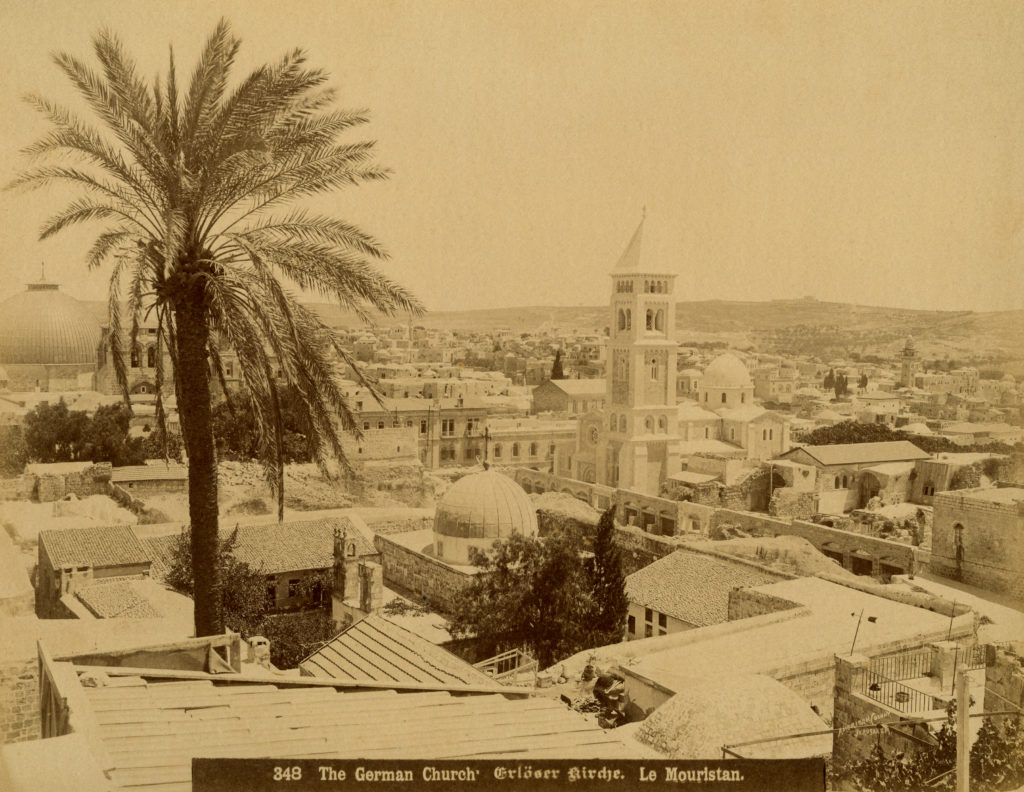 The German Church, ca. 1900 American Colony (Malikian Collection)
The German Church, ca. 1900 American Colony (Malikian Collection) 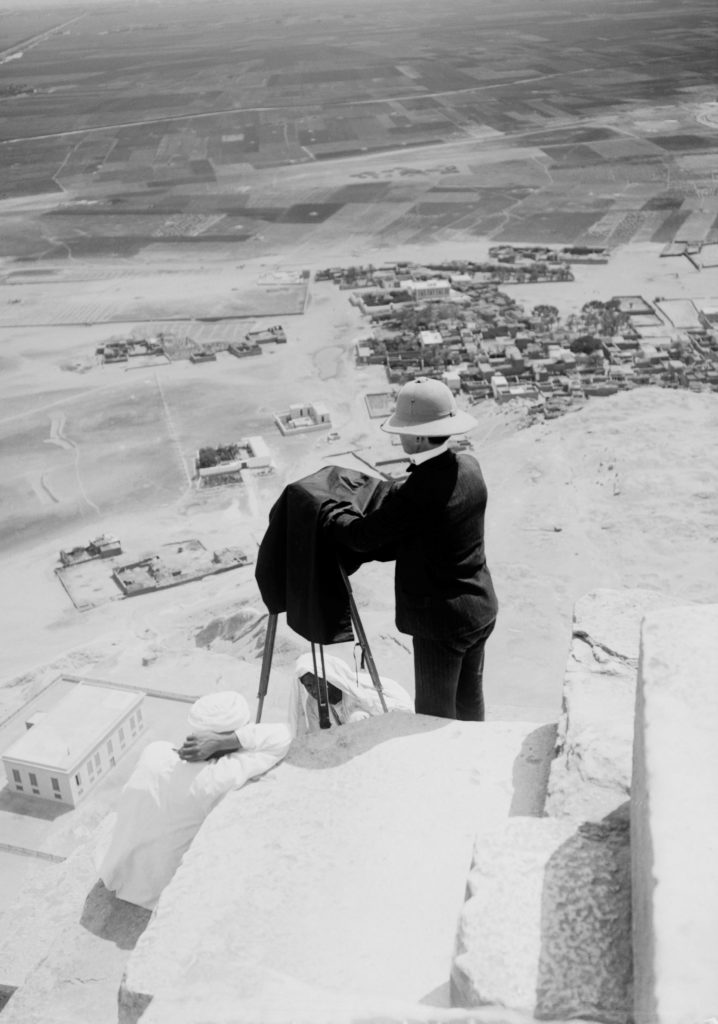 Lewis Larsson on an expedition with two guides atop the Great Pyramid at Giza, 1905 Photographer Furman O. Baldwin (Matson Collection, LOC)
Lewis Larsson on an expedition with two guides atop the Great Pyramid at Giza, 1905 Photographer Furman O. Baldwin (Matson Collection, LOC)
Lewis Larsson (1881-1958), one of the most skillful of the American Colony photographers, was part of the original group of Swedish colonialists who arrived in Jerusalem in 1896. Apprenticed by Elijah Meyers around age 17, Larsson emerged in 1910 as de facto leader of the photo department as Meyers gradually transferred his duties to his apprentices. Larsson has been described by Nir as being part of “a new style of photography, by which he was not concerned with subject alone, but made use of light and shadows to dramatize his views and provide his subjects with a scene of plasticity.” With his mastery of photography, Larsson traveled extensively in pursuit of images capturing historic Palestinian sites, towns and villages as well as its indigenous peoples. He assumed a position as Vice Consul and later Swedish Consul for Palestine from 1920 to 1925. However, he continued to photograph major historic events associated with World War I and the collapse of Ottoman rule in Palestine.
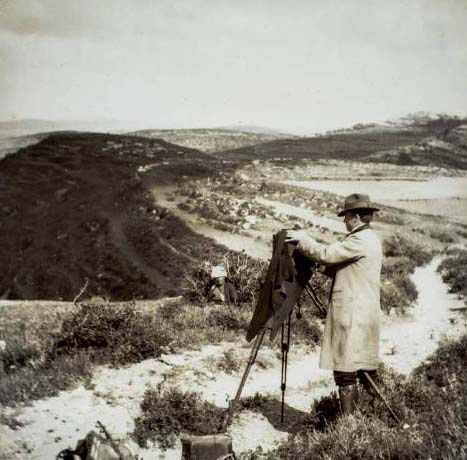 Lewis Larsson photographing at Tibne, Jordan, 1910 (ACPD Upssala University Library Collection)
Lewis Larsson photographing at Tibne, Jordan, 1910 (ACPD Upssala University Library Collection) 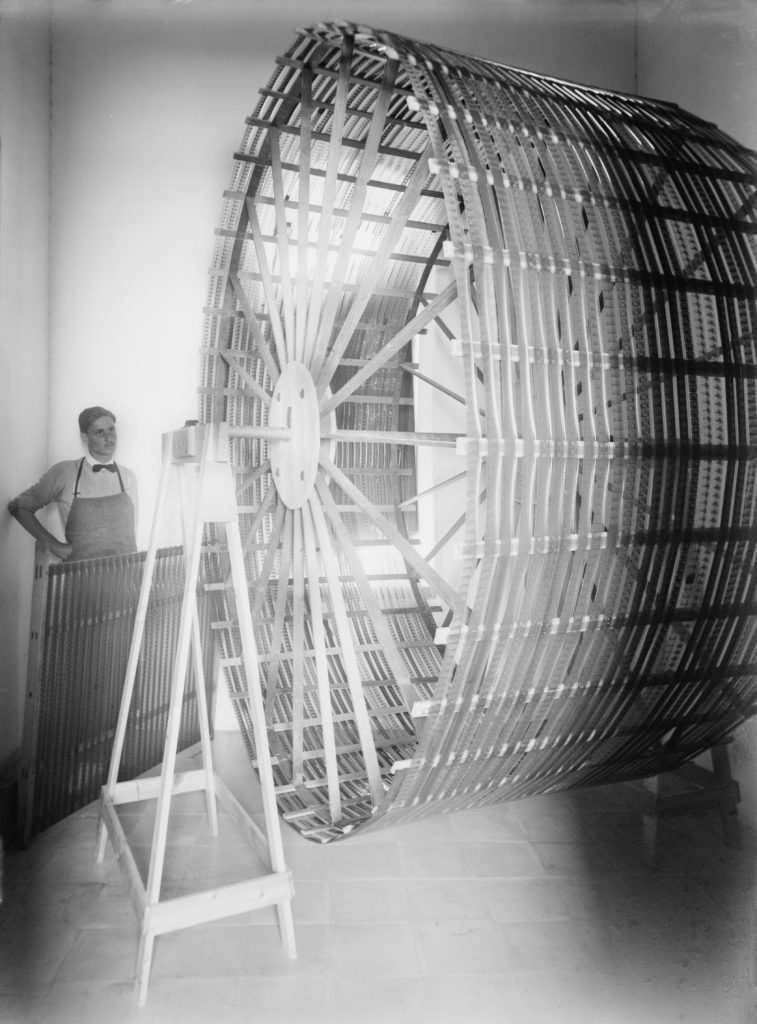 Jamil Albina with a film dryer, ca. 1920. American Colony (Matson Collection, LOC)
Jamil Albina with a film dryer, ca. 1920. American Colony (Matson Collection, LOC)
Around 1920 Larsson and members of his staff, Jamil and Najib Albina experimented with the production of motion pictures after Larsson came in contact with a Swedish filmmaker. Tom Powers notes, “The technique involved winding the exposed film onto specially-built racks which were then transferred by hand through a series of watertight tanks; the processed film was finally removed from the racks and wound on a giant spool for drying. Most of this equipment was of wooden construction, no doubt crafted in the Colony’s own carpentry shop.”
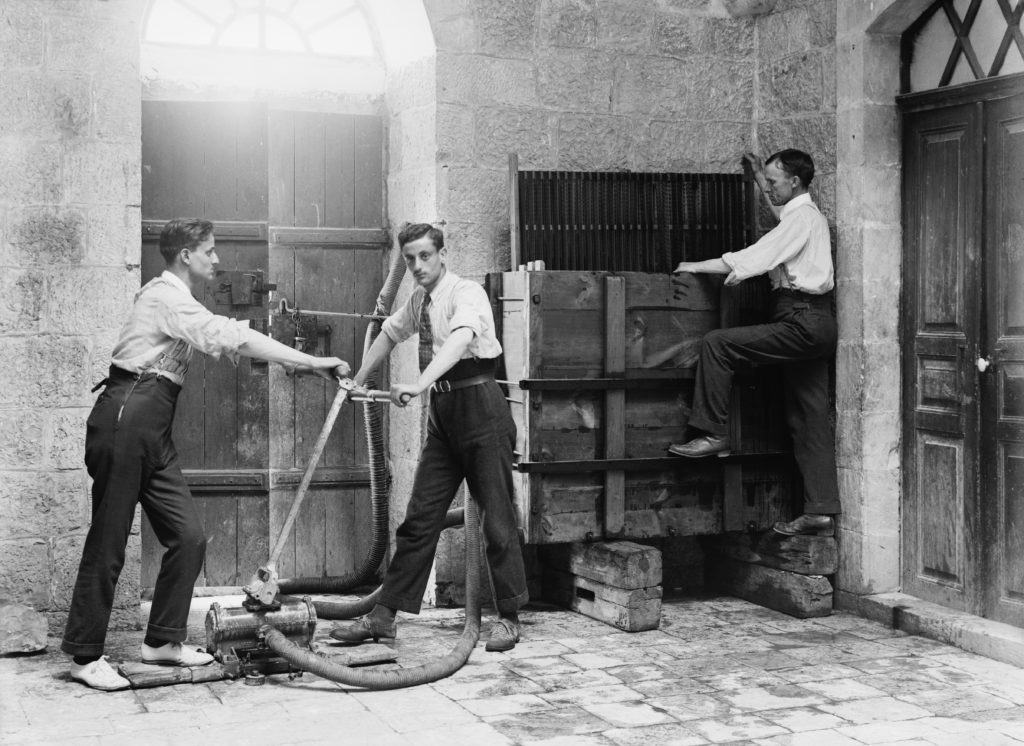 Jamil and Najib Albina, and Lewis Larsson processing motion picture film, ca. 1920. American Colony (Matson Collection, LOC)
Jamil and Najib Albina, and Lewis Larsson processing motion picture film, ca. 1920. American Colony (Matson Collection, LOC) 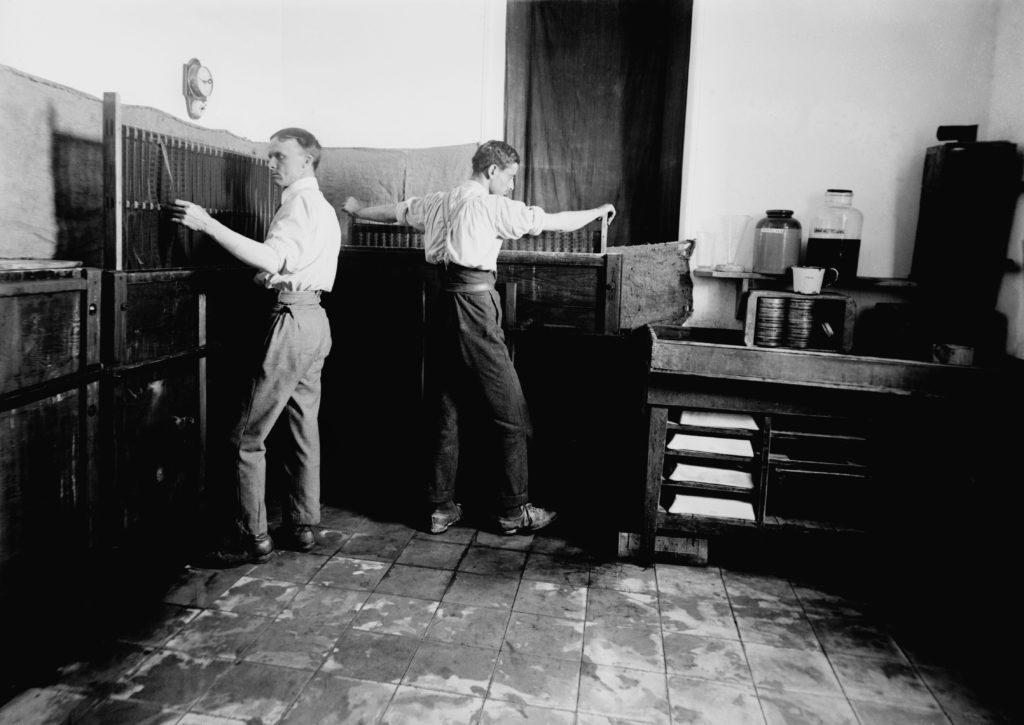 Lewis Larsson and Jamil Albina developing film in the darkroom. American Colony (Matson Collection, LOC)
Lewis Larsson and Jamil Albina developing film in the darkroom. American Colony (Matson Collection, LOC)
The growing dissension amongst the American and Swedish members of the American Colony and its reorganization by the American contingency prompted Lewis Larsson and his family to formally part from the Colony in 1930.
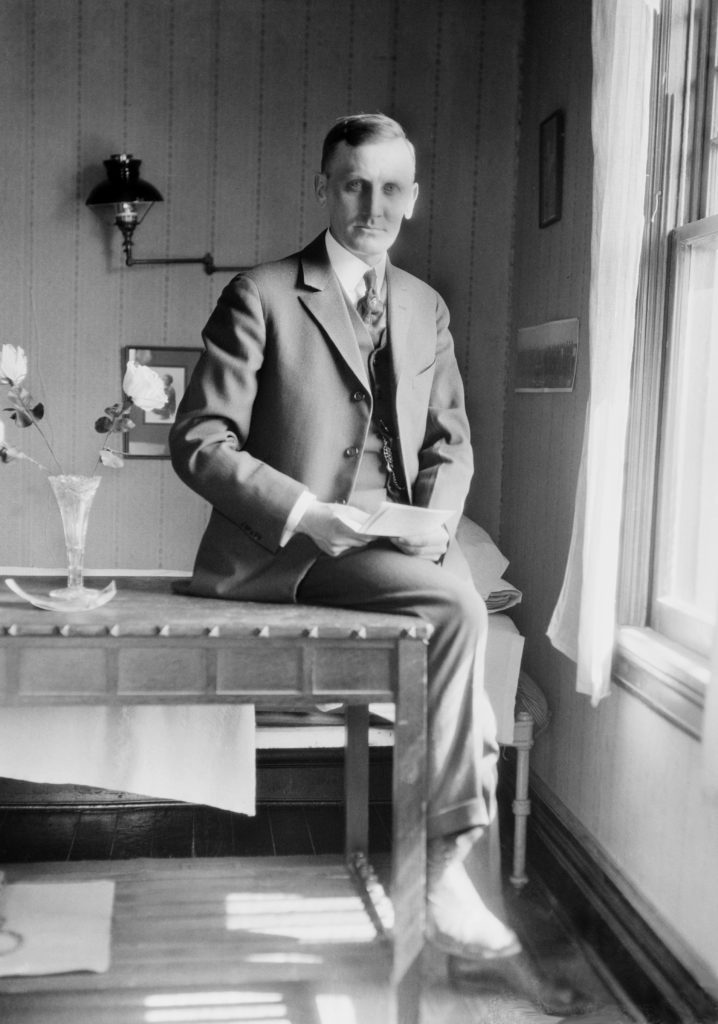 Eric Matson, ca. 1935. Matson Photo Service (Matson Collection, LOC)
Eric Matson, ca. 1935. Matson Photo Service (Matson Collection, LOC)
The Matson Photo Service
G. Eric Matson (1888-1977) born in Nas, Sweden came to the American Colony as a young child with his family in 1896. As a teenager in the early 1900s, Matson began working in the darkroom of the photo department. Initially he was promoted as an assistant and in the early 1920s he assumed greater responsibilities as first assistant to Lewis Larsson. Matson’s marriage to Edith Yantiss, an American from Kansas who came to the American Colony in 1896, brought him closer to members of the American community within the Colony. Both Matson and Yantiss met as co-workers in the darkroom. Throughout their partnership, they were credited with innovative photographic techniques such as “coloring photographs with oil paint, producing double stereoscopic photographs to create 3-D pictures, infrared photography, and aerial work.”
When the American Colony disbanded in 1930 following discord between the Americans and the Swedes, Eric and Edith Matson stayed with the American Colony. Eric Matson assumed leadership of the photo department until 1934 when the Matsons left the Colony. With his departure, Matson was given the Colony’s photo archive and some of its photographic equipment. He re-located the business to the lower end of Jaffa Street near the Fast Hotel and re-named it “The Matson Photo Service.”
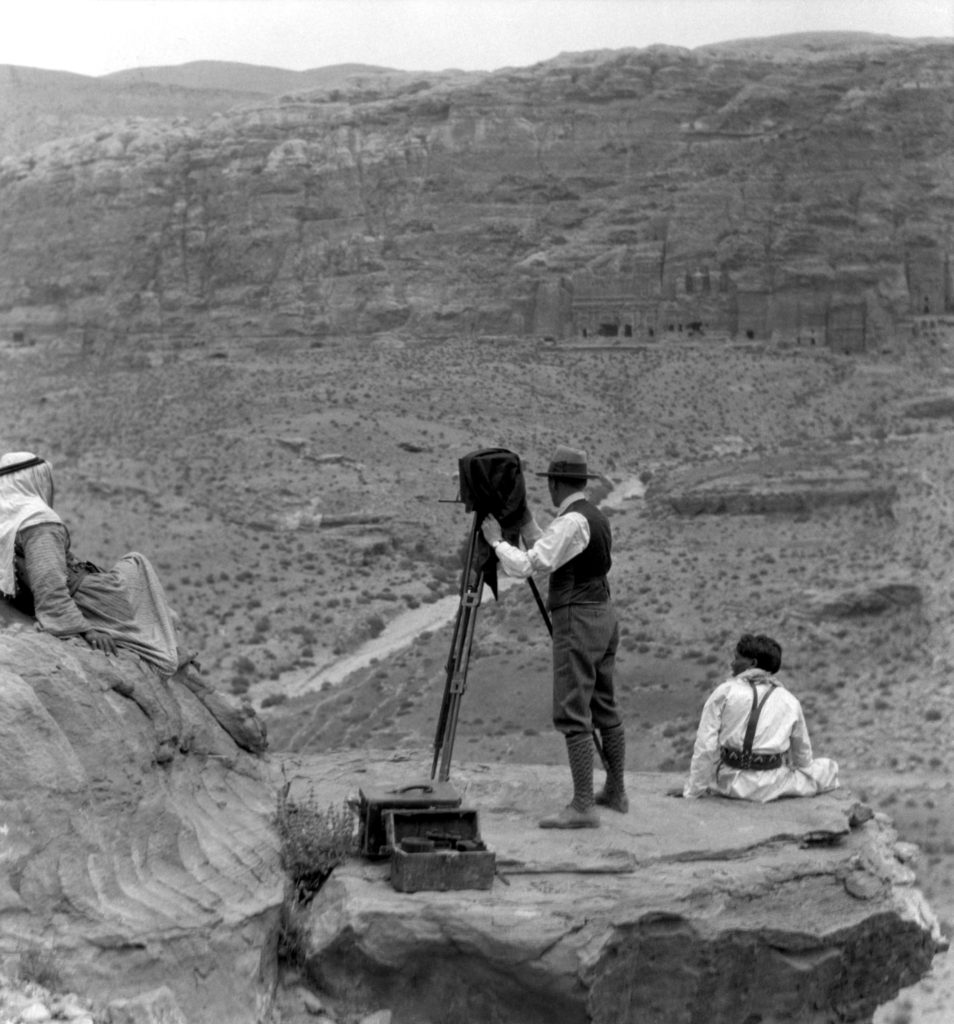 Eric Matson with tour guides photographing in Petra, 1934 (Matson Collection, LOC)
Eric Matson with tour guides photographing in Petra, 1934 (Matson Collection, LOC) 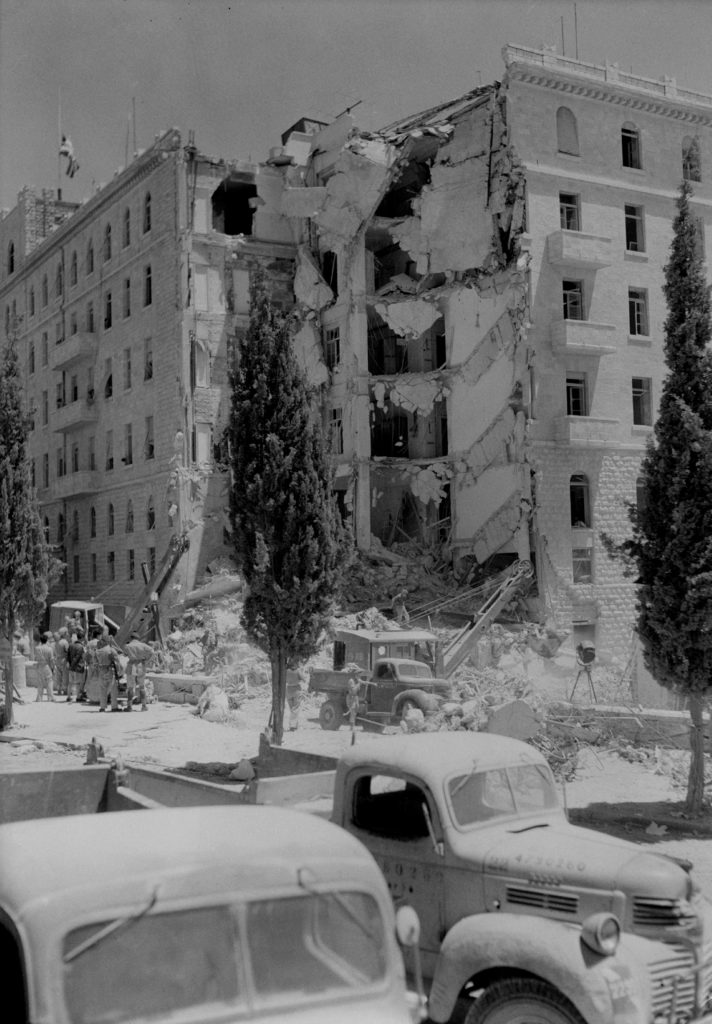 Terrorist attack of the King David Hotel on July 22, 1946 by the right-wing Zionist militant underground, Irgoun. Matson Photo Service (Matson Collection, LOC)
Terrorist attack of the King David Hotel on July 22, 1946 by the right-wing Zionist militant underground, Irgoun. Matson Photo Service (Matson Collection, LOC)
John Whiting, Hanna Safieh and Joseph H. Gries worked under Matson during the years of expansion of services to the tourist market, local newspapers, and international magazine and book publishers. With growing tension between the Arabs and the Jews in 1946, the Matsons and their three children left Jerusalem for Southern California taking with them approximately two-thirds of the archive they had amassed from the American Colony and from their work dating back to 1934. The final photographs recorded in Matson’s Jerusalem catalogue were those of the bombing of the King David Hotel by the Zionists. Following Matson’s departure in 1946, the Jerusalem business continued to operate for approximately five years. The store on Jaffa Road sustained significant damage during the 1948-1949 conflict between the Arabs and the Jews. A waning in tourism during the early 1950s caused the dispersion of Matson’s staff and forced the Jerusalem business to close. At different times during this conflict-laden period in Palestine, many of Matson’s negatives were shipped to the United States. The Matsons continued to sell photographs of the Holy Land from their home in California.
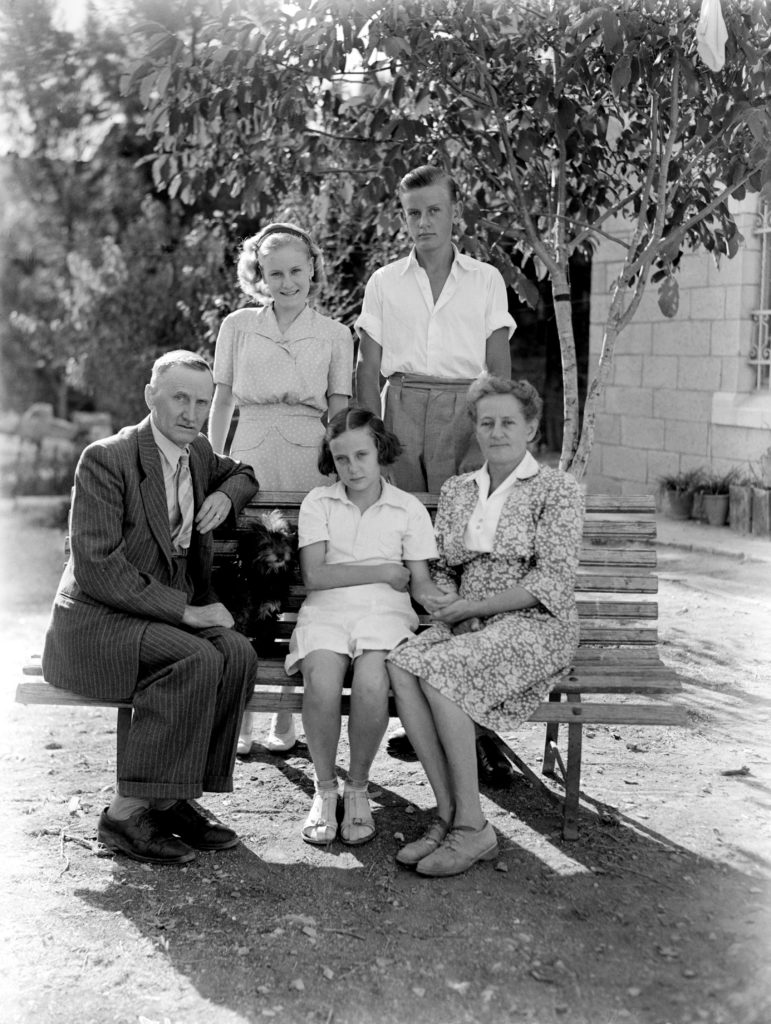 Eric and Edith Matson with their children, Anne, David and Margaret, in the garden of their Jerusalem home, ca. 1940 (Matson Collection, LOC)
Eric and Edith Matson with their children, Anne, David and Margaret, in the garden of their Jerusalem home, ca. 1940 (Matson Collection, LOC)
Today, through the Library of Congress, one can access approximately 20,000 images produced by the American Colony and the Matson Photo Service. Matson was fully aware of the historic value of these images that he had amassed. As such, following a period of negotiation with the Library of Congress, the images were donated at different intervals with Matson assisting the staff in organizing and identifying the photographs.
The Matson Collection is a treasure trove that documents Palestine over the course of five decades. The current exhibit is based on Matson’s images produced around 1935 to 1940. It consists of nine envelopes containing the best of Matson’s photos which he and his staff selected and thematically organized for distribution to the tourist market. These images which were intended for the tourism trade currently serve as unequivocal documentation that Palestine before 1948 was a vibrant and culturally rich land inhabited by diverse ethnic and religious communities coexisting in relative peace and harmony. These visual representations challenge the widely cited assertion that Palestine was an empty and desolate land.
I extend my appreciation to Tom Powers who is credited with providing a comprehensive description and analysis of “Jerusalem’s American Colony and its Photographic Legacy.”
Photographs in this exhibit are part of the Matson Collection at the Library of Congress. The original images contained within the nine thematically organized envelopes once sold to the tourist market are part of the Malikian Collection.
- Tom Powers, “Jerusalem’s American Colony and its Photographic Legacy” reviews.datasciencedojo.com/Jerusalem_s_american_colony_tom_powers.pdf
- Tom Powers, https://israelpalestineguide.wordpress.com/2015/10/18through-american-colony-lens-photographers-at-work/
- http://www.loc.gov/pictures/collection/matpc/colony.html
- http://www.loc.gov/pictures/collection/matpc/background.html
- https://www.loc.gov/exhibits/americancolony/amcolony-family-html
- https://en.wikipedia.org/wiki/Horatio Spafford
- https://en.wikipedia.org/wiki/American_Colony,_Jerusalem
- Bair, Barbara. The American Colony Photography Department: Western Consumption and “Insider” Commercial Photography. Jerusalem Quarterly 44 (2010): 22-38.
- Geniesse, Jane Fletcher (2008). American Priestess: The Extraordinary Story of Anna Spafford and the American Colony in Jerusalem. New York: Doubleday.
- Nir, Yeshayahu (1985). The History of Photography in the Holy Land 1839-1899. Philadelphia: University of Pennsylvania Press.
- Vester, Bertha Spafford (1950). Our Jerusalem: An American Family in the Holy City, 1881-1949. Garden City, NY: Doubleday.




